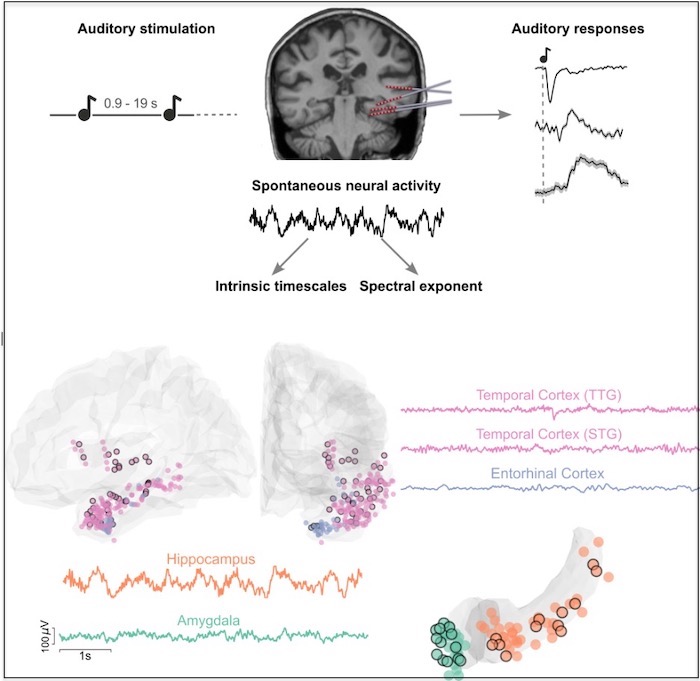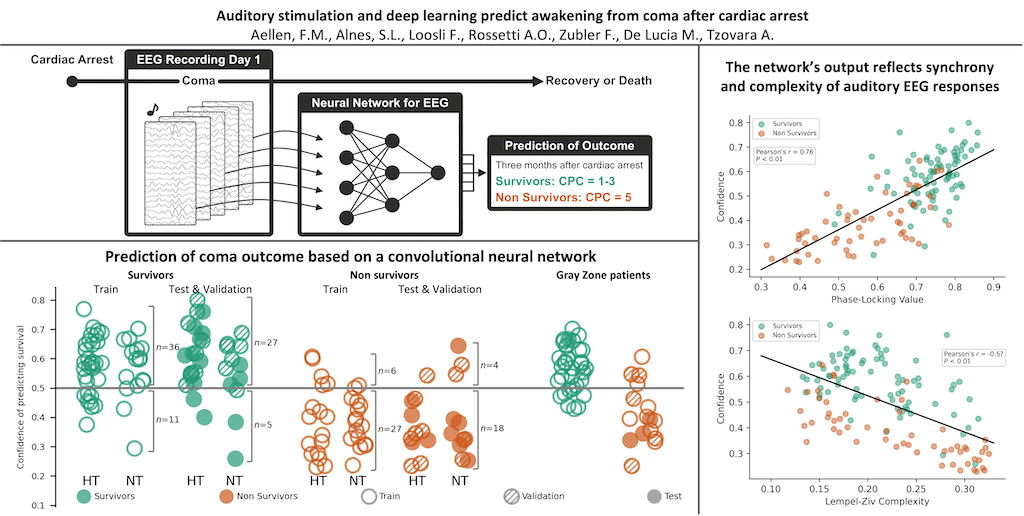Cognitive Computational Neuroscience
Research
Our research uses computational and machine learning techniques to study functions of the human brain in health and disease. Our work focuses on three main axes:
- Auditory processing and predictions
- Neural functions in coma and sleep
- Machine learning algorithms for neuroscience
Auditory processing and predictions
 Figure from: Cusinato, Alnes et al., 2023
Figure from: Cusinato, Alnes et al., 2023
The world around us is full of rich sensory experiences, which often follow repetitive rules. Environmental
regularities can help us learn patterns from our environment and form predictions about future events before these
occur.
To shed light into the neural mechanisms that support processing of environmental stimuli and the formation of predictions about future events, we are using scalp and intracranial electroencephalography (EEG, iEEG), in combination with computational modeling techniques.
Representative publications
- Cusinato R *, Alnes SL *, van Maren E, Boccalaro I, Ledergerber D, Adamantidis A, Imbach LL, Schindler K, Baud MO, Tzovara A (2023) Intrinsic neural timescales in the temporal lobe support an auditory processing hierarchy. Journal of Neuroscience, * Equal contribution.
- Tzovara A, Fedele T, Sarnthein J, Ledergerber D, Lin JJ, Knight RT (2022) Auditory prediction hierarchy in the human hippocampus and amygdala, preprint.
- Tivadar R, Knight RT, Tzovara A (2021). Automatic sensory predictions: a review of predictive mechanisms in the brain and their link to conscious processing, Frontiers in Human Neuroscience.
Neural functions in coma and sleep
 Figure from Alnes et al., 2021, Neuroimage
Figure from Alnes et al., 2021, Neuroimage
When consciousness fades away we are not aware of our surroundings. However, our brains continue to process information from the environment, like sounds.
In our work, we are investigating how the human brain responds to stimuli of the environment when consciousness is lost. Moreover, we are combining electrophysiological measurements of brain activity with computational techniques, like measures of neural synchrony and complexity, or deep learning algorithms, to identify predictors of awakening from a coma.
Representative publications
- Aellen FM, Alnes SL, Loosli F, Rossetti AO, Zubler F, De Lucia M, Tzovara A (2023) Auditory stimulation and deep learning predict awakening from coma after cardiac arrest, Brain.
- Alnes S, Bächlin L, Schindler K, Tzovara A (2023) Neural complexity and the spectral slope characterize auditory processing in wakefulness and sleep, preprint.
- Alnes S, De Lucia M, Rossetti AO, Tzovara A (2021). Complementary roles of neural synchrony and complexity for indexing consciousness and chances of surviving in acute coma, Neuroimage.
Machine learning algorithms for neuroscience
 Figure adapted from: Aellen et al., 2023
Figure adapted from: Aellen et al., 2023
As the amount of data in the field of neuroscience and neurology increases, it becomes imperative to have powerful algorithms for analysing them. Machine learning algorithms have revolutionized several fields, but their use in electrophysiological data remains limited. In our work, we are developing deep learning pipelines for analysing electrophysiological data, with emphasis on interpretability, and clinical applications, such as predicting outcome from post anoxic coma. Moreover, we are evaluating the effects of algorithmic bias when applying machine learning techniques on medical data.
Representative publications
- Aellen FM, Kavis-Göktepe P, Apostolopoulos S, Tzovara A (2021). Convolutional neural networks for decoding electroencephalography responses and visualizing trial by trial changes in discriminant features, Journal of Neuroscience Methods.
- Norori N, Hu Q, Aellen F, Faraci F, Tzovara A (2021). Addressing bias in big data and AI for health care: A call for open science, Patterns.